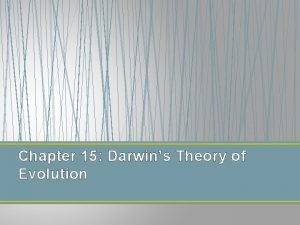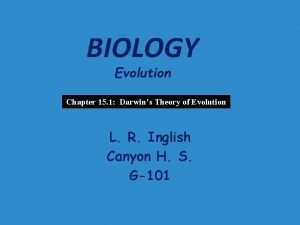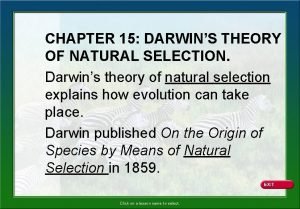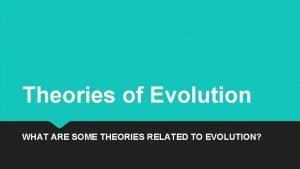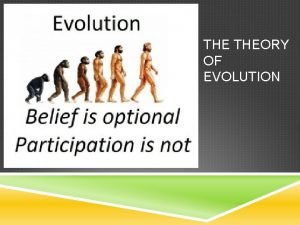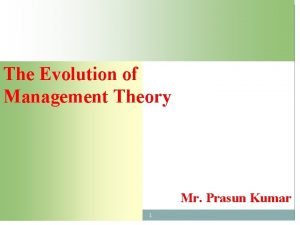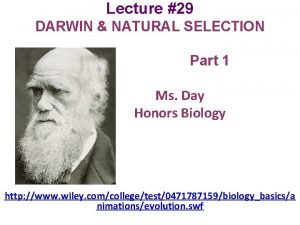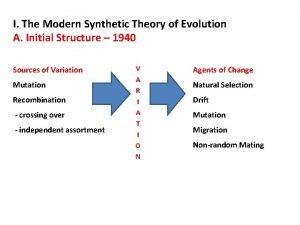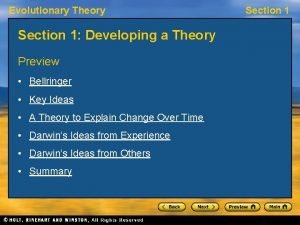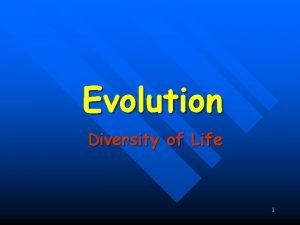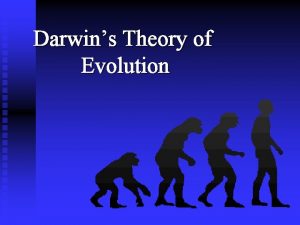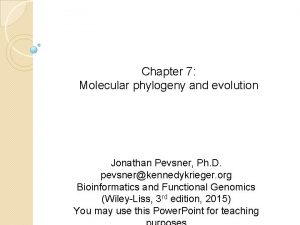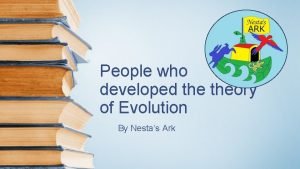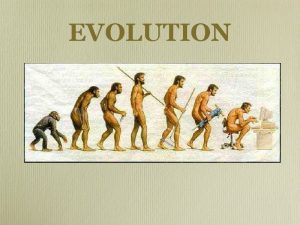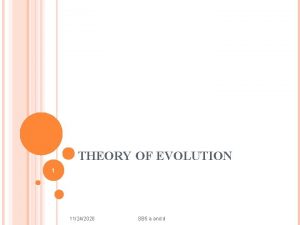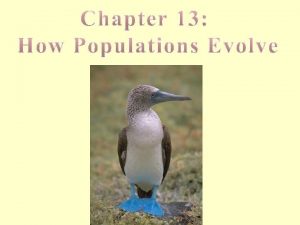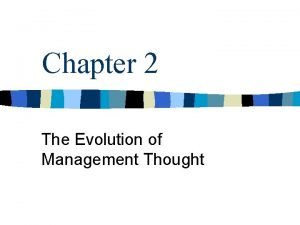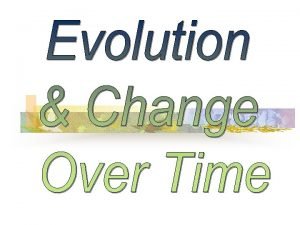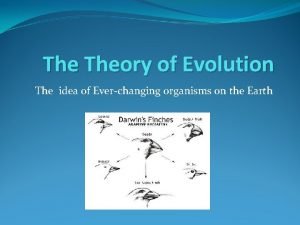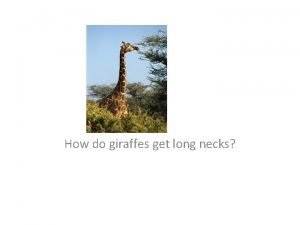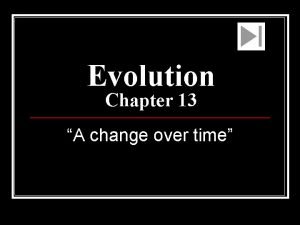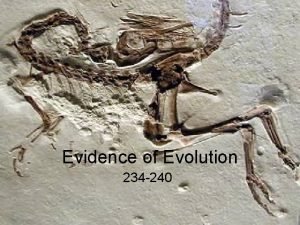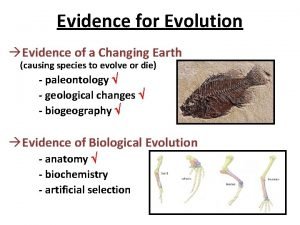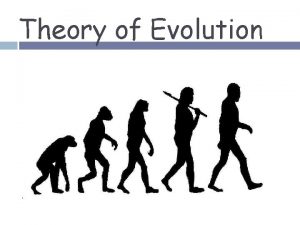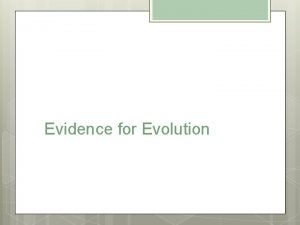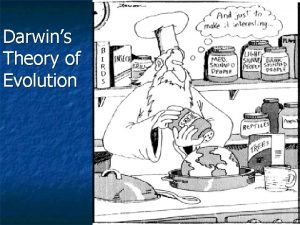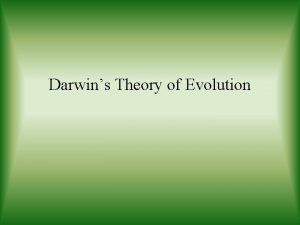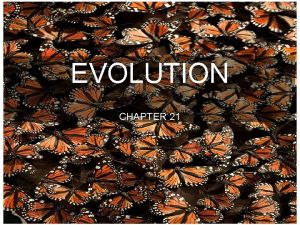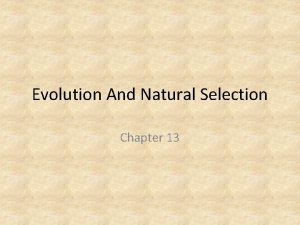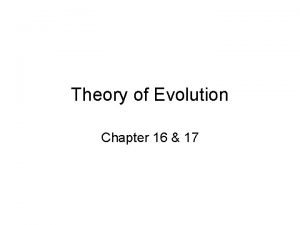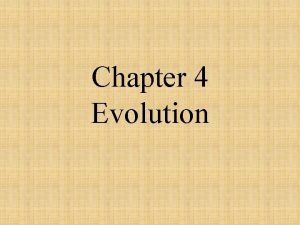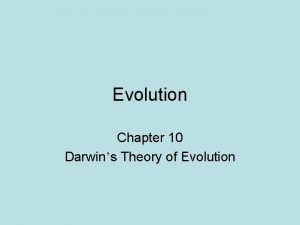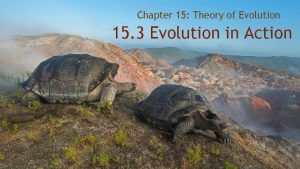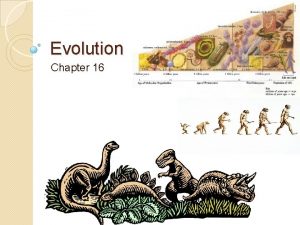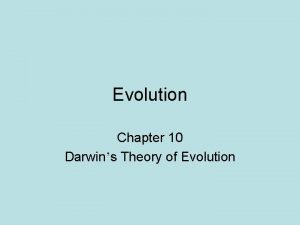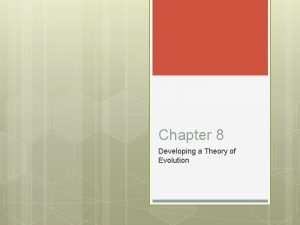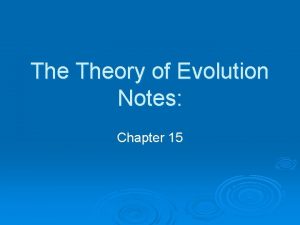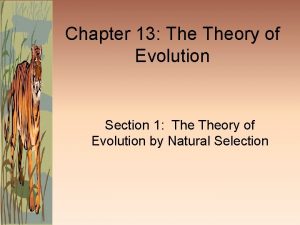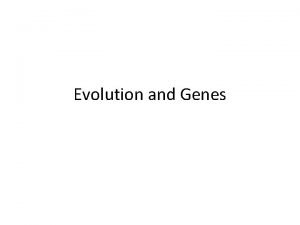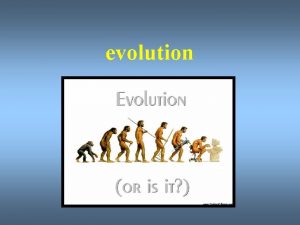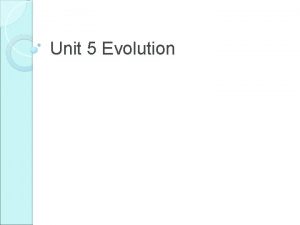The Theory of Evolution Chapter 16 Copyright Mc






























- Slides: 30

The Theory of Evolution Chapter 16 Copyright © Mc. Graw-Hill Companies Permission required for reproduction or display

What is Evolution? • Change over time • Fossil evidence shows that living things have not always been the same as today

History of theory… • James Hutton (1785) – Earth formed very slowly, earth is old – Forces beneath the earth’s surface act to form mountains, rocks, and valleys

History of theory… • Thomas Malthus (1798) – Predicted that the human population would grow faster and larger than the space and food supplies will allow – Predicted there would be a great struggle for survival, leading to wars and famine

History of theory… • Jean-Baptiste de Lamarck (1809) – Was the first to propose a mechanism for evolution – Hypothesized that the environment influenced the development of traits – Inheritance of acquired traits

Lamarck’s Theory • Acquired traits are developed as needed – Example: • long neck of giraffe • Fins and tail of a dolphin

Lamarck’s Theory-problems… • Acquired traits are passed on to offspring – We know that only traits that are controlled by genes can be passed down to future generations • A trait that is not needed will be lost – We know that an organism cannot “lose” a trait it had at the start of its life, because traits are controlled by its genes

History of theory… • Charles Lyell – His book, Principles of Geology, explained that earth continues to change just as it has for millions of years – And processes that have shaped (and continue to shape) the earth are very slow

History of theory… • Charles Darwin (1832) – Set sail as ship’s naturalist on the HMS Beagle – Read the works of Malthus, Hutton, and Lyell while sailing around the world – Collected evidence that would be used to support his developing theory

History of theory… • Alfred Wallace (1858) – Wrote to Darwin speculating on evolution by natural selection

Darwin’s Theory • On the Origin of Species (1859) • Individuals differ and some of the variation is inheritable • Many more offspring are born than can survive • There is competition for resources • Each individual has advantages and disadvantages in the struggle to survive • Those most adapted to the environment will survive and pass their traits on

Evidence to support Darwin’s Theory 1. Fossil record

Evidence to support Darwin’s Theory 2. Natural Selection Changes Populations v Darwin collected a closely related group of 13 finch species in the Galapagos Islands. v All similar except for beak characteristics. - Beak correspondence suggested to Darwin that they were shaped by evolution. Ø Nature of available food supply. Example: Beaks of Darwin’s Finches

Evidence to support Darwin’s Theory 3. Homology in the Anatomical Record v Structures with different appearances and functions that all derived from a common ancestor.

Evidence to support Darwin’s Theory 3. Emryological Development v Different organisms exhibit similar embryological forms.

Evidence to support Darwin’s Theory 4. The Molecular Record (DNA, RNA, proteins) Distantly related organisms are expected to accumulate a greater number of evolutionary differences than closely related species.

Natural selection Peppered Moths and Industrialized Melanism • Until the mid-nineteenth century, Peppered Moths, Biston betularia, had predominately light-colored wings. v Industrial smog helped turn lichens on tree trunks dark. v Subsequently, dark individuals became predominant. - Predators see them! • • Second half of the twentieth century saw widespread implementation of pollution controls, thus trends reversed and light colored moths again dominated. But, caution must be taken, as the selective agent could be some factor other than wing coloration.

When two groups of the same species are separated, changes may occur in each population that eventually causes them to be so different that speciation occurs • • Geographic Isolation v separated by land formations such as rivers, mountains, valleys, etc Reproductive Isolation v separated due to inability to mate with each other - Structural, mating time is different, etc Temporal Isolation v Separated by time factors such as circadian rhythms Behavioral Isolation v Separated by behavioral differences such as courtship dances or sounds

Artificial Selection • Agriculture v Kernel characteristics of corn.

Artificial Selection • Domestication v Breeds and characteristics of dogs.

The Anatomical Record • Vestigal Structures v Organs with no apparent modern function, but resemble ancestral structures.


The Evolution of Horses • Modern members of Equidae (horses, zebras, donkeys) are descendents of lineage originating in the Eocene Period 55 mya. v Earliest known members were species in genus Hyracotherium. - Small size - Multiple toes - Small, simple teeth. v Evolutionary change has not occurred at a constant rate.

Types of Evolution • • Convergent Evolution - Selection that favors changes making two or more groups more similar. v Similar solutions to similar problems. - Marsupial-Placental Convergence Divergent Evolution - Selection that favors changes making two or more groups less similar. v Exposure to different selective pressures.

Weaknesses of theory… • Cannot explain how the first life began – First single cell – First multi-cellular organism

Weaknesses of theory… • Relies on random mutation as the explanation for change – Most mutations are harmful

Weaknesses of theory… A “missing link” is not known for any two species – All species seem to have come into being independently of any other

More like a lizard or a bird? • Theory changes as more evidence is found – Dinosaur theory

Darwin’s Critics • • Evolution is not solidly demonstrated. There are no fossil intermediates. Intelligent Design. Evolution violates Second Law of Thermodynamics. Proteins are too improbable. Natural Selection does not imply evolution. The irreducible complexity argument.

Copyright © Mc. Graw-Hill Companies Permission required for reproduction or display
 Chapter 15 darwin's theory of evolution
Chapter 15 darwin's theory of evolution Chapter 17 darwins theory of evolution
Chapter 17 darwins theory of evolution Chapter 15 darwin's theory of evolution section review 15-1
Chapter 15 darwin's theory of evolution section review 15-1 Homologous structures definition biology
Homologous structures definition biology Natural selection
Natural selection Lamarck's theory of evolution
Lamarck's theory of evolution Developmental homology
Developmental homology Evolution of management theory
Evolution of management theory What was lamarck's theory of evolution
What was lamarck's theory of evolution Modern synthetic theory of evolution notes
Modern synthetic theory of evolution notes Modern evolution theory
Modern evolution theory Lamarck’s theory of evolution.
Lamarck’s theory of evolution. Vestigial
Vestigial Neutral theory of molecular evolution notes
Neutral theory of molecular evolution notes Shaping evolutionary theory
Shaping evolutionary theory Charles darwin theory of evolution
Charles darwin theory of evolution Who formulated theory of evolution? *
Who formulated theory of evolution? * Lamarck theory of evolution notes
Lamarck theory of evolution notes Theory of evolution
Theory of evolution Theory of evolution
Theory of evolution The evolution of management theory
The evolution of management theory What does darwin's theory of evolution suggest?
What does darwin's theory of evolution suggest? Darwin's postulates
Darwin's postulates Lamarck theory of evolution notes
Lamarck theory of evolution notes Darwin's theory of evolution
Darwin's theory of evolution Analogous structures definition
Analogous structures definition The theory that evolution occurs slowly but steadily
The theory that evolution occurs slowly but steadily Lamarck's theory of evolution
Lamarck's theory of evolution The theory that evolution occurs slowly but steadily
The theory that evolution occurs slowly but steadily Hình ảnh bộ gõ cơ thể búng tay
Hình ảnh bộ gõ cơ thể búng tay


